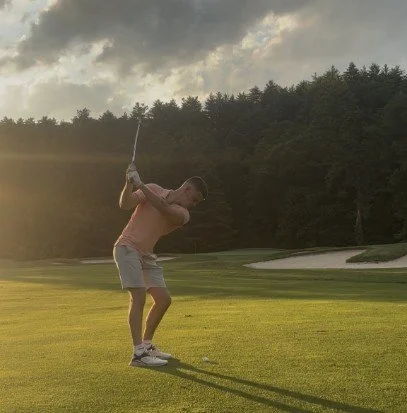Meet Matt Wagner, our summer intern landscape architect at BA&A. Matt has been involved in the landscaping industry since his first job at Millican Nurseries. He earned his associate’s degree in Landscape and Environmental Design from New Hampshire Technical Institute in 2024 and spent last summer building hands-on experience with a local design/build company. Currently, Matt is a senior at the University of Rhode Island, where he is pursuing his bachelor’s degree in Landscape Architecture.
Throughout the summer, Matt has been a valuable part of the BA&A team, and we’ll certainly miss having him around. Before he heads back to school, let’s take a closer look at his journey and what he’s learned during his internship.
How did you first get interested in landscape architecture? Was there a class, project, or experience that sparked your interest?
Well, my first job was working at a local tree nursery, and I have always enjoyed being outside. When I thought about what I wanted to pursue after high school, I did not know landscape architecture was a career until one someone at the nursery mentioned it to me. Once I was enrolled in the Landscape Design program at NHTI, one of my professors further boosted my interest by his passion for the field and how much it has to offer. He quickly showed me that becoming a landscape architect was what I wanted to do.
Can you walk us through your design philosophy? How do you approach new landscape projects?
The main philosophy I have is to analyze areas outside of the site too. I think understanding the vernacular of the area is essential to creating a cohesive and fitting design. I also think for any project it is important to remember what the client desires. It is easy to design, and then suddenly drift away from the original wants of the client. I am designing for them, not myself.
What are some key things you’ve learned during your internship?
Changes always happen and I have learned it is important to be able to react quickly and efficiently to them. The design of the house changed, how can I adjust my design to accommodate the changes while creating a successful landscape? Certain plants are unavailable, what is a good replacement that still meets the function and style I am going for? Or the client's budget changed, where can I make adjustments to meet the landscape budget? Being able to manage and react to these changes is crucial and results in a better project.
I also learned that asking questions never hurts. On jobsites I would often ask the home builders some questions that did not relate to landscape architecture. I did this because I was quite curious, but I also want to become well versed in building architecture as well. Then picking Senior Landscape Architect, Greg Rusnica’s brain has been very beneficial for me. Asking why he made this design choice or why he chose this plant has done nothing but help me become a better designer.
Has this experience changed or influenced the way you see landscape architecture as a career?
This experience has assured me that I want to pursue becoming a Licensed Landscape Architect. Seeing Greg’s weekly workflow is something that I could see myself doing. Jumping around to different job sites, completed or active. Doing different designs for every client. Speaking with all types of contractors like surveyors, arborists, or home builders. The variety of work he does is something I would find enjoyable.
What’s been your favorite project or task to work on during your internship so far?
My favorite project that I got to work on was a project in Quechee, Vermont. Firstly, I loved the site and how different it was compared to some of the others I worked on. It has a water feature, but it is not a lakefront property, so it felt like there was a lot of space to work with. I also enjoyed this project because I worked on the multiple pieces it had. Building the site model in AutoCAD, calculating a pricing estimate of the landscaping features, making construction details and elevations, developing a 3D landscape model, creating a rendering of the whole property, and making an illustrative site plan. It was enjoyable to work on all of these parts for one project. Out of all of those tasks, the rendering was my favorite part, because it was amazing to see a 2D plan come to life in 3D.
Do you have any favorite native plants that you like to incorporate into landscape designs?
I personally like to incorporate serviceberry (Amelanchier canadensis). Some say it is a tree, some say it is a shrub. I think it is a large shrub. It is a deciduous, multi-stemmed shrub growing anywhere from 15-25’ tall. In the fall the sleek gray bark contrasts nicely with its vibrant reddish orange fall foliage. It prefers wetland conditions but can be utilized in urban environments. Beautiful white flowers emerge in early to mid-spring and the berries will attract the neighboring birds. It can do it all.
Another shrub I like to use is low growing fragrant sumac (Rhus aromatica). It may not have the most appeal from spring through summer, but once the fall hits, the leaves turn a bright red. It also functions as an erosion controller. When planted on a slope behind a retaining wall, it not only functions well, it creates a sea of red in the fall.
What are your hobbies outside of landscape architecture?
Outside of landscape architecture, I golf most of the time. Probably too much. But then I also play basketball leisurely with friends or competitively in local men’s leagues. When I am not doing something sports related, I like to spend time hanging out with my friends, playing cards or board games.


